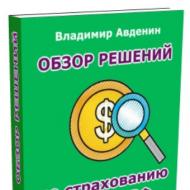
Refinancing rate then. Definition and concept of the refinancing rate of the Central Bank of the Russian Federation (Bank of Russia). When the rate may change
But what is it in simple words, by whom and for what it is installed and why is it changing all the time? We will talk about this in our article.
What is the refinancing rate
The central bank of any country concentrates in its hands not only huge financial flows, but also a certain power. So, he regulates the activities of all other banks in the country, issues them licenses or revokes them, thereby making their further activities illegal.
The Central Bank also issues loans to banks and other financial institutions. Back, these institutions return the money with interest. The interest rate is determined by the refinancing rate in the RF.
The value of the refinancing rate lies in the fact that it largely depends on the percentage at which citizens receive loans from banks. It is clear that no bank will issue a loan at an interest lower than the Central Bank rate. It will be financially disadvantageous. After all, you need not only to "work out", that is, to recoup the interest on the loan taken from the Central Bank in order to return the loaned amount of money on time and in full, but also to recoup the work of specialists, offices, to get a net profit, finally. That is why the banks' rate is always higher than the refinancing rate, and not by one percentage point, but at least by 3-4, and more often by 7-8 and even more.
But what does the indicator set by the Central Bank of the Russian Federation depend on? From the inflation rate in the country. The higher it is, the higher the CP will reach, since only its growth can restrain the rise in prices.
In economics, there is also the concept of "negative rate". This is when the bank gives a loan at zero or very low interest. Or even under negative, for example, under -0.1%. This helps to counter inflation that is too low. Additional money is entering the country's economy, which becomes too much, and it begins to depreciate. This leads to higher prices, which stimulates the growth of inflation. In Russia, such steps have never been taken, but in other countries, for example, in Denmark, the EU, Japan, this fact was recorded.
So, the refinancing rate in simple words is the rate on loans that the Central Bank of a country issues to all commercial banks in this country. The lower it is, the cheaper the loans and the faster inflation starts to grow.
Why is she needed
It would seem that the simplest answer to the question of why such a rate is needed is making money by the Central Bank. After all, he gives out not millions - billions and even more. It is easy to imagine what kind of income the Central Bank has, even if the interest at the refinancing rate is only 10-11 points.
But in reality, everything is more complicated. The value of the refinancing rate is very high for the entire economy as a whole.
The size of the refinancing rate is not determined based on how much the Central Bank wants to get rich. As we saw above, there are times when this indicator is set to negative values. No, its size depends on the inflation rate in the country.
Let's take a look at how this mechanism works.
For example, inflation is at high level and continues to grow. What does it mean? That for the same amount of money at the beginning of the year and at the end (or even with a difference of a couple of months) you can buy different quantities of the same product. For example, for 100 rubles in March it was possible to buy 3 kg of sugar, and in June - already only 2 kg 700 g. This means that goods are becoming more expensive, that is, inflation is growing.
What is the Central Bank doing in such a situation? Raises the bank's refinancing rate. Loans for banks are issued against greater percentage... It becomes unprofitable for banks to give them to the population at a low interest rate. They also raise interest rates on consumer, mortgage and car loans. People begin to take out loans less willingly, especially for goods - the demand for consumer loans is falling sharply. People stop buying goods that they, by and large, can do without - appliances, furniture, expensive clothes. To spur demand and boost sales, sellers begin to cut prices. Lower prices lead to a drop in inflation, because now for the same amount of money you can buy more of the same product (the same sugar that fell in price, because no one wanted or could not buy expensive sugar - there was not enough money, and loans became too expensive).
It is clear that the example with sugar is exaggerated - people always buy food. But expensive delicacies and luxury items are optional, and they are purchased only when there is a surplus of money. Therefore, it is they who are getting cheaper, causing a decrease in inflation.
Regulation of the Central Bank rate in in this case- is it good or bad? After all, as soon as inflation falls, the refinanced rate falls. Then loans become cheaper, people begin to take them more willingly (no one wants to overpay a lot) and no longer deny themselves the purchase of goods for which they do not have enough of their own savings.
People buy goods, demand rises, stimulating supply - sellers order more and more goods from enterprises, enterprises increase production. At the same time, high demand also spurs the rise in prices - the store sees that the goods are being sold well, and increases the price tag. Prices rise - inflation starts to rise again. And at this moment, the Central Bank again raises the refinancing rate to make loans more expensive and less affordable.
As people whose welfare suffers because of the high cost of goods begin to express dissatisfaction with the authorities, inflation is also important indicator stability and tranquility in the country. The Central Bank is appointed to regulate this indicator.
V loan agreements you can often find such a thing as a one-day refinancing rate. It is on the basis of it that the amount of interest and fines is determined. This indicator is calculated simply - annual percentage divided by the number of days in the year.
Who sets the refinancing rate
The refinancing rate in Russia is set by the Central Bank. Since January 1, 2016, this concept has become obsolete and now it is equated to the key rate, which determines at what percentage the Central Bank issues loans to commercial banks for a period of one week. And also this minimum rate, under which loans are issued to banks. The Central Bank accepts deposits at the same percentage.
Who sets the size of this indicator? The refinancing rate is determined by the Board of Directors of the Central Bank (or the Bank of Russia, as it is also called). What kind of decision was made is reported in official sources, where the Central Bank's Resolutions are published.
What determines how often the accepted meaning will be revised? From the current economic situation in the country. Sometimes the Board of Directors meets for this purpose three times a year. Sometimes - more often. So, in 2017, the indicator changed 6 times, moreover, the rate for the year decreased by 2%. This means that inflation was not high.
We figured out which body approves the size of this indicator. What else, besides inflation figures, he focuses on:
on the state financial market in general, the mood prevailing there and the ongoing objective processes,
on prices for hydrocarbons,
on the interest that citizens show in loans,
You can predict what this indicator will be. But it is impossible to calculate it in advance using a certain formula.
What does it affect
The impact of the refinancing rate on the economy occurs, first of all, by curbing inflation and devaluation of the national currency. This means that in order to make a decision on the next revision of the rate up or down, the bank needs information about these indicators.
The impact on the economy does not occur spontaneously - each time the Central Bank analyzes a lot of parameters before once again decreasing or increasing the SR.
For ordinary citizens, in addition to the fact that this indicator affects the cost of loans and deposits, it is also important that the key rate affects:
calculation of penalties for unpaid loans, taxes and fines;
calculation of the amount of income taxes on cash deposits;
calculation of the percentage of the forfeit that the employer must pay to the employee for failing to pay him wages or other payments due in accordance with labor legislation.
But there are other levers as well.
Inflation
First of all, the dependence is visible between what percentage is set by the Central Bank and what percentage on loans and deposits is set by banks.
Secondly, it has an impact on inflation - as we wrote above, this is an important tool for regulating inflationary processes. The refinancing rate and inflation are directly dependent - the higher one indicator, the higher the second.
The demand for money decreases with an increase in the rate - no one wants to take out expensive loans. It's one thing to buy a sofa, overpaying 18% of its cost from a loan. And it is a completely different matter when you have to overpay already a quarter of its cost, or even more. In such cases, people either try to borrow money from their acquaintances, or save up, or completely abandon an expensive purchase by reconsidering their preferences and spending structure.
Interest calculation
For example, the interest rate is mentioned in many contracts as a benchmark for the amount of fines and penalties for late payment of funds, borrowed or earned.
In banks, this is how they calculate what the penalty will be if the next loan payment is delayed. To find out this level, you need to insert the following values into the formula:
the current size, which is equal to the refinancing rate in Russia,
the number of days for which the payment was overdue,
the amount that the client owes the bank (that is, not the entire loan balance, namely the amount that the borrower had to pay on the date of the next payment, but did not pay).
At the same time, the amount of interest for which the loan was issued does not matter.
The formula for the penalty interest is as follows:
calculating the one-day rate by dividing the refinancing rate by the number of days in a year;
multiplying the resulting number by the number of days during which the delay was admitted;
multiplying the resulting number by the amount that the borrower did not pay to the bank on time (the amount owed).
What this formula means in practice - let's look at a specific example.
For example, on the date of the next payment, the borrower did not pay an amount of 10,000 rubles. A debt was formed, which he delayed by 20 days. What penalty has managed to run during this time is calculated as follows:
7.75% (current rate) / 365 (days) = 0.0212%.
0.0212 (%) * 20 (days) = 0.425.
0.425 * 10,000 (rubles) = 4,246 rubles.
It is this amount that the borrower will have to pay if he has not requested a loan restructuring in time (for example, a deferred payment) in his bank for a good reason.
Reduced refinancing rate
If you look at the table that shows the rate increases and decreases by year, you will notice that in 2017 it fell. In general, a consistent decline has been observed since 2014, when the rate began to decline after a sharp rise. What are the consequences of such a policy? And what a new wave of decline can lead to interest rate?
Firstly, this negatively affects banking investments. After all, investing money is interesting when you can get large percentage... But banks set the interest on deposits based on the CP level. If the percentage is small, then the profit will be small.
Secondly, this will have a positive impact on the lending sector. Loans will become cheaper, people will be more willing to take them. Small and medium business for whom loans will also become more profitable will also benefit.
Thirdly, a decrease in SR leads to a decrease in the unemployment rate.
Fourth, the national currency is losing value.
Fifth, there is an increase in inflation.
The mechanism of why inflation increases due to a decrease in SR has been described above. Reducing the refinancing rate, under other conditions, leads to a blowout big money in the economy, the rapid development of business and production, an increase in the mass of commodities and demand for it. The demand for loans is increasing, as evidenced by the statistics of banks.
But how to determine when there will be a decrease in this indicator and whether there will be any? Experts predict that 2018 will be held in conditions of a further decrease in HR. And this is good - as we know, in developed countries this figure is much lower than now in Russia. So we still have something to strive for.
The Central Bank may refuse to cut the rate if the price of hydrocarbons falls. Or if the economic situation in the country worsens. Macro economic indicators will also be taken into account. Perhaps the CP rate will drop to 7%, economists say. This will contribute to the further increase in the rate of economic growth.
When the rate may change
There is a certain schedule according to which the SR changes. For example, if the meeting of the Board of Directors took place on December 18, 2017, then the next meeting at which Central bank may revise this value, it will be appointed no earlier than 09.02.2018.
When the refinancing rate will be changed, it is said in press releases published on the official website of the Central Bank. Even the Government does not know what the next refinancing rate of the Central Bank will be - the final decision is taken collectively by the directors of the bank during the meeting. Regulation is completely placed in the hands of the leadership of the Central Bank, but subject to a decision based on a comprehensive analysis of important factors.
For the first time since the economic crisis of 2008, the Central Bank lowered the SR in April 2009. At that time, it was 11.5%. In 2013, this figure was even 5.5%. However, then another crisis followed. In 2014, SR reached a record 17 percent.
The current SR can only be canceled by establishing a new value at the next meeting of the Board of Directors of the Bank of Russia.
History in table and graph
The history of SR dates back to January 1, 1992. Since then, she has managed to change more than a dozen times. Track changes for last years can be found in the table below.

As can be seen from the table, the SR changes both three times a year and much more often. So, in 2008 it changed 6 times. And in 2009 - as much as 9 times, that is, almost every month. This was due to the outbreak of 2008 economic crisis, which affected not only Russia, but also many countries of the world. The role of the regulator in such a situation increases many times over, since it has the task of ensuring the stability of the national currency and inflation.
You can also comment or ask a question
The refinancing rate is the main indicator of the economy in the country, it is set by the Central Bank Russian Federation... This indicator determines the annualized interest rate at which the Central Bank issues loans to commercial banks if they do not have enough funds. The change in the rate takes place at the direction of the Bank of Russia.
What is the refinancing rate for?
Now the refinancing rate is 6.5%. This value is valid from October 2019. This indicator is applicable in such cases:
- if the loan rate is less than the refinancing rate, the borrower pays personal income tax;
- when there is a delay wages;
- if the developer violates the deadline for transferring the property to a potential home owner.
There is a calculator on our website that will help you calculate the amount required to reimburse in all these cases.
Banks are responding to an increase in the refinancing rate with an increase in the interest rate on loans, and the rates for placing deposits are also changing.
The refinancing rate from January 1, 2016 is equal to the key rate. This indicator has been in effect since September 2013. Now an independent indicator of the refinancing rate is not established; when the key rate changes, the refinancing rate also changes. The key rate reflects the relationship between the Central Bank of the Russian Federation and commercial banks in a short time.
Refinancing rate and inflation
“Inflation” simply means rising prices. With its high level, the incomes of the population are significantly reduced, they can afford to buy less goods for the same funds. With high inflation, the refinancing rate is reduced, loans become cheaper, the population is more willing to take them, and the welfare rises. When inflation is low, the refinancing rate rises. Loans are becoming more expensive, it is no longer so easy for the population to issue them. Sales are declining, people buy only essential goods.
The refinancing rate directly affects the inflation rate in the country and vice versa. With a decrease in inflation, prices go down, loans become more affordable, and the population willingly takes them. The opposite situation: enterprises can attract more cheap money to business, thereby significantly increasing the volume of products, the demand for goods increases, sellers raise the cost of sold products, inflation and, accordingly, the refinancing rate increases.
Additional features of the refinancing rate
The refinancing rate plays a role in the calculation of deposits and deposits. Additionally, the following spheres of influence of this indicator can be distinguished:
- with the help of it, penalties and fines are calculated in case of violation of the payment of taxes, payments for utilities... Penalties here are calculated based on 1/300 of the rate for each day of delay;
- a deposit that brings income more than the refinancing rate by 5 points is taxed. In this case, the holder of the deposit pays income tax individuals in the amount of 30% of the amount of accrued interest;
- V Tax Code, where it is included in the calculation of the amount of fines and penalties in case of non-compliance with the payment procedure established taxes and fees.
Another decrease in the key rate of the Central Bank of the Russian Federation occurred on September 6, 2019. The rate has decreased by 0.25% and is now 7%. V this year this key indicator for Russian economy has already been corrected downward three times. According to the official information of the Bank of Russia, at the next meetings of the Board of Directors this issue will be raised again, that is, the refinancing rate of the Central Bank of the Russian Federation may again be reduced in 2019. The table from the official website of the regulator about the rate change is given in the article.
It is noted that the rate cut is due to a slowdown in the development of the Russian and world economies, as well as a decrease in inflation. Forecast of the Central Bank of the Russian Federation on the inflation rate by the end of the year: 4-4.5%. Read more about what the refinancing rate is and how it is applied in Russian legislation.
Definition of the term and its history
The refinancing rate was introduced back in 1992. By the instruction of the Central Bank of the Russian Federation (Bank of Russia) dated 11.12.2015. it was equated to the key rate.
To explain what the refinancing rate is understandable language, without economic terms not enough. In fact, this is the percentage per annum at which the Central Bank lends commercial banks, and the key rate is a short-term interest rate, according to which the Central Bank is ready to provide weekly loans to commercial banks and accept deposits from them for the same period.
Thus, this indicator affects the cost of loans for the population. The rate of inflation depends on what rate is in effect in the country, what is its size. Wanting to lower the inflation rate, the Bank of Russia raises the key rate, banks are forced to raise interest on loans, making them less affordable, which leads to a decrease in purchasing power and a decrease in pressure on loans. national currency... The refinancing rate is used for tax purposes and for calculating interest and penalties in accordance with the law.
Meaning

The refinancing rate of the Central Bank of the Russian Federation for today in 2019 is equal to the key rate, since it has not been established separately since 2016 (clause 2 by the indication of the Central Bank of the Russian Federation of December 11, 2015). The key rate of the Central Bank of the Russian Federation for today is 7%. This value is set in accordance with the information of the Central Bank of the Russian Federation dated September 6 of the current year.
According to the Central Bank of the Russian Federation, they decided to lower the rate taking into account many factors. One of them was the reduction of the forecast for inflation rates to 4.0-4.5%. The slowdown in the development of the Russian and world economies also played a role, as stated in the official press release of the Bank of Russia.
Let's give an example of how the rate changed during 2017-2019 in the table.
Refinancing rate of the Central Bank of the Russian Federation for 2019: table (official website of the Central Bank of the Russian Federation - source)
| Date from which the rate is applied | Value (Percentage) | Bank of Russia information on the establishment of this value (date) |
| 27.03.2017 | 9,75 | 24.03.2017 |
| 02.01.2017 | 9,25 | 28.04.2017 |
| 19.06.2017 | 9 | 16.06.2017 |
| 18.09.2017 | 8,5 | 15.09.2017 |
| 30.10.2017 | 8,25 | 27.10.2017 |
| 18.12.2017 | 7,75 | 15.12.2017 |
| 12.02.2018 | 7,5 | 09.02.2018 |
| 26.03.2018 | 7,25 | 23.03.2018 |
| 17.09.2018 | 7,5 | 14.09.2018 |
| 30.10.2018 | 7,5 | 26.10.2018 |
| 17.12.2018 | 7,75 | 14.12.2018 |
| 14.06.2019 | 7,5 | 17.06.2019 |
| 26.07.2019 | 7,25 | 29.07.2019 |
| 06.09.2019 | 7,75 | 09.09.2019 |
How to calculate interest and liquidated damages?
Here are the main cases of using the refinancing rate.
| Measure of responsibility | Legal justification | Calculation rules (the current refinancing rate is taken into account, unless otherwise indicated) | Value (as a percentage of the amount owed) |
| Penalty for late payment of taxes and fees | Item 4, Art. 75 of the Tax Code of the Russian Federation | If the delay has arisen for individuals and legal entities before October 1, 2017 - one three hundredth of the refinancing rate for each day of delay of the amount owed | |
| If the debt has arisen after October 1, 2017 for individuals, similar rules apply. | |||
| If the debt arose after October 1, 2017 for legal entities; For a delay of up to 30 calendar days inclusive, then one three hundredth of the refinancing rate of the Central Bank of the Russian Federation is applied in the same way For a delay of more than 30 calendar days, penalties are set in the amount of 1/300 for the first 30 days of delay and 1/150 for each day of delay, starting from 31 |
0,0242 | ||
| Forfeit or penalty for non-performance monetary obligations if the parties have not agreed on the size | Art. 395 of the Civil Code of the Russian Federation | 1/360 for each day of delay | 0,0201 |
| Penalty or fine for late payment for a residential property or utilities | Clause 14 Art. 155 LCD RF | 1/300 of the rate in effect on the day of actual payment, for each day of delay, starting from the 31st day following the day of payment, for debt formed in the first 90 days of delay; Starting from 91 days of delay 1/130 of the refinancing rate in effect on the date of actual payment |
0,0242 |
| Penalties established for the employer for delayed wages, vacation pay and other payments to the employee | Art. 236 of the Labor Code of the Russian Federation | Not less than 1/150 for each day of delay. The size can be increased by collective agreement | 0,0483 |
| Penalty or penalties of the developer in case of violation of the term established for the transfer of a residential object to a participant shared construction | Item 2, Art. 6 FZ-214 | 1/300 of the rate in effect on the day of fulfillment of the obligation, for each day of delay If a participant in shared construction is an individual - 1/150 |
0,0242 |
The Penalty Calculator can be found on various sites, including Arbitration court... You can make the calculation yourself, it's quite simple.
For example, the amount owed is 15,000 rubles, the delay is 10 days. Here is the calculation for 1/300 and 1/150 of the refinancing rate.
- 15,000.00 × 10 × 1/150 × 7% = 70 rubles
15,000.00 × 10 × 1/300 × 7% = 35 rublesThus, the formula is as follows: amount of debt * refinancing rate / 300 * number of days of delay.
The refinancing rate for 2019 was set by the Central Bank at 7%, why do commercial banks continue to issue loans at higher interest rates?
The difference between the refinancing rate and the rates on loans from commercial banks is actually a fee for intermediary services of credit institutions. The Central Bank of the Russian Federation, in accordance with the current legislation, can control the issuance of certain loans, but it does not have the right to directly limit interest, they are formed by market processes.
It should be added that the refinancing rate of the Central Bank of the Russian Federation for today in 2019 is 7% - until recently it was a fairly low figure for Russia, but compared to other countries, the rate continues to remain at a high level. In the USA, for example, it is 1.75%, in the UK - 0.5%.
This is one of the instruments of monetary policy.
The refinancing rate (discount rate) is initially annual rate in the percentage at which commercial credit institutions are provided with borrowed funds by the Central Bank.
The goal is to stabilize money circulation on the territory of the Russian Federation and stimulate market economy.
12/13/2019 The Central Bank lowered the key rate to 6.25%.
On October 25, 2019, the Central Bank lowered its key rate to 6.50%.
09.09.2019 The Central Bank reduced the key rate to 7.00%.
07/29/2019 The Central Bank lowered the key rate to 7.25%.
06/14/2019 The Central Bank lowered the key rate to 7.5%.
From 17.12.2018 refinancing rate 7.75%
- Later, this tool began to be used as a starting point in calculating late fees for taxes, fees and contributions.
- Calculations are made from 1/300 of the discount rate for the overdue day from the specified moment, until the date of actual payment, of the amount owed.
Refinancing rate for today
From 17.12.2018 refinancing rate 7.75%. Since the refinancing rate and the key rate are equal, there are ranges of values depending on the type of operation and instrument:
- For operations to provide cash liquidity for a period of 1 day of standing, the rate is 8.5%;
- For operations to provide cash liquidity for a period from 2 to 549 days of standing 9.25%;
- For operations on the open market to provide cash liquidity for a period of 2-3 months of constant action, the rate is 7.75%;
- For open market operations to provide cash liquidity for a period of 1 to 2 days, from 1 to 6 days, and for 1 week of standing, the rate is 7.50%;
- For open market operations to absorb cash liquidity for a period of 1 to 6 days, the rate and for 1 week is equal to the key rate of the Central Bank;
- For standing operations to absorb cash liquidity for 1 day, the rate is 6.50%;
- Standing operations for the absorption of cash liquidity on demand from 05/17/2018. are conducted only for 1 day with "today" settlements, overnight deposits.
The specified percentages are valid from 17.09.2018.
What is the refinancing rate
The discount rate is used in calculating the tax on material benefits arising from savings on interest, when using borrowed money am received from legal entities. It is expressed in rubles, depends on the volume of the loan and amounts to 2/3 of the rate share.
Such financial instrument It is used to determine the amount of monetary compensation that the employer must reimburse in case of delay in payment of wages. The calculation is carried out, as well as the penalty for repayment of taxes - 1/300 of the overdue day.
The Civil Code of the Russian Federation allows claiming the amount of interest from the borrower based on the refinancing rate, if the interest obligations are not reflected in the contractual relationship. Breach of contractual obligations is also regulated by this financial instrument (fines, penalties, violation of delivery times, delay in payments, etc.).
From 01.01.2016 the refinancing rate is set together and corresponds to the key rate of the Central Bank of the Russian Federation. Accordingly, a separate refinancing rate from 2016. not used on its own, but left by default.
Key rate Is the percentage corridor in which:
- the minimum percentage at which commercial banking organizations take cash liquidity for 1 week;
- the maximum percentage at which deposit operations of commercial banking organizations are carried out for a period of 7 days.
Deposit transactions, deposit auctions, repo auctions and “currency swaps” also depend on the discount rate.
Raise or lower the discount rate is decided by the supreme leadership of the Central Bank of the Russian Federation at a special meeting. Meetings are held every 6 weeks. The meeting analyzes the economic indicators of the development of the market economy, the possible consequences of changes in quotations and financial risks.
What does the increase in the refinancing rate mean?
The increase means that the Central Bank of the Russian Federation has begun active preventive measures to stabilize the economy. But an increase in the discount rate can have completely opposite effects - unwinding inflation, disrupting production and economic stability. Additional criteria, by which the effect of a rate hike can be predicted are, the amount of cash money supply and currency speculation.
What happens when the rate goes up?
If there is no injection of money supply, then inflation will decrease, the profitability of deposits will increase, and the national currency will strengthen.
Otherwise, we will face a devaluation of the ruble, capital flight abroad, an increase in the cost of goods and services, a decrease in production rates, an increase in the number of unemployed, the cost of borrowed funds will increase, a decrease in taxes to the budget, an increase in tariffs natural monopolies, an increase in fines and penalties in organizations that depend on the discount rate, a decrease in purchasing power, investment outflow.
Betting statistics for recent years
On the day of commissioning January 01, 1992. the refinancing rate was 20%, and it grew steadily. In the 90s, maximum values of 200% were recorded. The Central Bank's instrument reached two-digit values only in the 2000s.
The statistics for recent years are as follows:
- in the period from September 13, 2013 to March 2, 2014 the rate was stable - 5.50%;
- from March 3, 2014 to April 27, 2014 it grew by 1.5% and amounted to 7%;
- from April 28, 2014 to July 27, 2014, and from July 28, 2014. to November 4, 2014 the discount rate gave an increase of 0.5% for the period - 7.50% and 8.00%, respectively;
- from November 5, 2014 until December 11, 2014 - 9.50%;
- in December, from December 12, 2014. until December 15, 2014 and from December 16, 2014. until February 1, 2015 the rate changed twice - 10.50% and 17.00%;
- from February 2, 2015 to May 4, 2015 dropped already to 14.00%;
- from May 5, 2015 to August 2, 2015 continued to decline to 11.50%;
- from August 3, 2015 decreased by 0.5% three times and equaled as of March 26, 2017. 10.00%.
- from March 27, 2017 to September 17, 2017 there was a loss of another 1% and the value was equal to 9.00%;
- from 18 September 2017 to December 17, 2017 not significant decrease - 8.25%;
- from December 18, 2017 to September 16, 2018 the indicator decreased three times and reached a value of 7.25%;
- from September 17, 2018 to October 28, 2018 - 7.5% first significant growth since February 2015
In addition to the above tasks, the discount rate has one more option. The rate is a tool to combat currency speculation. The goal is to ensure that currency speculation does not bring in excess of profits. Although often the Central Bank itself arranges a panic on currency exchanges in order to squeeze the ruble money supply and contain rapidly rising inflation. Moreover, it is not only a financial instrument, but also a bright indicator of monetary policy.
The refinancing rate of the Central Bank of the Russian Federation for today is 6.25% (coincides with the key rate)
This is the annual percentage at which another can get a loan from the Central Bank of the Russian Federation credit organization... In a number of foreign countries a term such as "Discount rate" can be used. The rate conventionally reflects the present value of money for the economy. From 13.09.2013, a separate one was introduced, which made the refinancing rate a secondary instrument. Since January 1, 2016, the refinancing rate has been equated to the key rate.
How it is calculated. Its final value is influenced by many factors: the state of the economy, inflation in the country, the level consumer prices, the situation on banking market and sometimes foreign policy.
What is it for and what does it affect
- Limiting the maximum rates on deposits and deposits. According to clause 7 of article 74 of the law on the central bank, the Bank of Russia has the right to impose a limit on the maximum interest rate on a deposit. Such a limitation cannot be:
- below 2/3 of the rate on deposits in rubles;
- lower LIBOR rate on deposits in foreign currency.
Thus, the lower limit of the deposit rate is 5.5% (at a rate of 8.25). The upper limit is determined based on the average maximum rate on deposits of TOP-10 banks (determined 3 times a month). - Interest rates on loans from commercial banks. Obtaining loans from the Central Bank is also one of the sources of obtaining funds for commercial banks. Consequently, the cost of these funds will also affect the final cost of the loan. Those. the lower the rate, the cheaper loans to end borrowers can be. At the same time, on the other hand, interest rates on deposits in this situation will decrease. Of course, there is no direct relationship here, but how the refinancing rate of the central bank of the Russian Federation influences is quite noticeable.
- Personal income tax on deposits. Income received in excess of the official rate by 5% is subject to tax. The refinancing rate today is 8.25%, therefore the tax-free% on the deposit is up to 13.25 inclusive. If you receive income for more high rate, then the difference will have to pay personal income tax 35% (Articles 214.2, 224 of the Tax Code of the Russian Federation).
Example: you opened a deposit at 15% per annum, for a period of 1 year in the amount of 500,000 rubles. The tax in this case can be calculated as follows:
Taxable base = (15% * 500,000) - (13.25% * 500,000) = 75,000 - 66250 = 8750
The amount of tax payable is 35 * 8750 = 3062.50 rubles.
With regard to individuals, a credit institution is the agent for paying tax, thus, you will be automatically withheld tax for transfer to the budget. Thus, on hand, at the end of the deposit agreement, you will receive 71,937.50 rubles. - Violation of the terms of payment of various taxes and fees. Regulated by clause 4 of article 75 of the Tax Code of the Russian Federation. Penalty interest is calculated in accordance with 1/300 of the current interest rate. To calculate various penalties, we recommend using ours, it already contains all the necessary calculation options.
- Interest for the use of strangers in cash, as well as material benefit from saving on them. According to Art. 212 of the Tax Code of the Russian Federation - calculated based on 2/3 of the current rate.
- Loan agreement without interest. According to paragraph 1 of Art. 809 of the Civil Code of the Russian Federation, interest is calculated as a single refinancing rate of the Bank of Russia.
- Material liability for delayed wages and other payments. According to Art. 236 of the Labor Code of the Russian Federation, in such cases, the employee must be charged interest for the delay based on 1/300 of the rate.
| Periods | % |
Refinancing rate 2019 |
|
| current refinancing rate of the Central Bank of the Russian Federation | equal to the value of the key rate of the Bank of Russia |
2019 year |
|
| December 16, 2019 - to date | 6,25 |
| October 28, 2019 - December 15, 2019 | 6,5 |
| September 9, 2019 - October 27 | 7 |
| July 29, 2019 - September 8, 2019 | 7,25 |
| June 17, 2019 - July 28, 2019 | 7,5 |
2018 year |
| December 17, 2018 - June 16, 2019 | 7,75 |
| September 17, 2018 - December 16, 2018 | 7,5 |
| March 26, 2018 - September 16, 2018 | 7,25 |
| February 12, 2018 - March 25, 2018 | 7,5 |
| December 18, 2017 - February 11, 2018 | 7,75 |
2017 year |
|
| October 30, 2017 - December 17, 2017 | 8,25 |
| September 18, 2017 - October 29, 2017 | 8,5 |
| June 19, 2017 - September 17, 2017 | 9 |
| May 2, 2017 - June 18, 2017 | 9,25 |
| March 27, 2017 - May 1, 2017 | 9,75 |
| September 19, 2016 - March 26, 2017 | 10 |
2016 year |
|
| June 14, 2016 - September 18, 2016 | 10,5 |
| January 1, 2016 - June 13, 2016 | 11 |
2012-2015 year |
|
| September 14, 2012 - December 31, 2015 | 8,25 |
2011 |
|
| December 26, 2011 - September 13, 2012 | 8 |
| May 3, 2011 - December 25, 2011 | 8,25 |
| February 28, 2011 - May 2, 2011 | 8 |
2010 year |
|
| June 1, 2010 - February 27, 2011 | 7,75 |
| April 30, 2010 - May 31, 2010 | 8 |
| March 29, 2010 - April 29, 2010 | 8,25 |
| February 24, 2010 - March 28, 2010 | 8,5 |
year 2009 |
|
| December 28, 2009 - February 23, 2010 | 8,75 |
| November 25, 2009 - December 27, 2009 | 9 |
| October 30, 2009 - November 24, 2009 | 9,5 |
| September 30, 2009 - October 29, 2009 | 10 |
| September 15, 2009 - September 29, 2009 | 10,5 |
| August 10, 2009 - September 14, 2009 | 10,75 |
| July 13, 2009 - August 9, 2009 | 11 |
| June 5, 2009 - July 12, 2009 | 11,5 |
| May 14, 2009 - June 4, 2009 | 12 |
| April 24, 2009 - May 13, 2009 | 12,5 |
Until 2008 |
|
| December 1, 2008 - April 23, 2009 | 13 |
| November 12, 2008 - November 30, 2008 | 12 |
| July 14, 2008 - November 11, 2008 | 11 |
| June 10, 2008 - July 13, 2008 | 10,75 |
| April 29, 2008 - June 9, 2008 | 10,5 |
| February 4, 2008 - April 28, 2008 | 10,25 |
| June 19, 2007 - February 3, 2008 | 10 |
| January 29, 2007 - June 18, 2007 | 10,5 |
| October 23, 2006 - January 28, 2007 | 11 |
| June 26, 2006 - October 22, 2006 | 11,5 |
| December 26, 2005 - June 25, 2006 | 12 |
| June 15, 2004 - December 25, 2005 | 13 |
| January 15, 2004 - June 14, 2004 | 14 |
| June 21, 2003 - January 14, 2004 | 16 |
| February 17, 2003 - June 20, 2003 | 18 |
| August 7, 2002 - February 16, 2003 | 21 |
| April 9, 2002 - August 6, 2002 | 23 |
| November 4, 2000 - April 8, 2002 | 25 |
| July 10, 2000 - November 3, 2000 | 28 |
| March 21, 2000 - July 9, 2000 | 33 |
| March 7, 2000 - March 20, 2000 | 38 |
| January 24, 2000 - March 6, 2000 | 45 |
| June 10, 1999 - January 23, 2000 | 55 |
| July 24, 1998 - June 9, 1999 | 60 |
| June 29, 1998 - July 23, 1998 | 80 |
| June 5, 1998 - June 28, 1998 | 60 |
| May 27, 1998 - June 4, 1998 | 150 |
| May 19, 1998 - May 26, 1998 | 50 |
| March 16, 1998 - May 18, 1998 | 30 |
| March 2, 1998 - March 15, 1998 | 36 |
| February 17, 1998 - March 1, 1998 | 39 |
| February 2, 1998 - February 16, 1998 | 42 |
| November 11, 1997 - February 1, 1998 | 28 |
| October 6, 1997 - November 10, 1997 | 21 |
| June 16, 1997 - October 5, 1997 | 24 |
| April 28, 1997 - June 15, 1997 | 36 |
| February 10, 1997 - April 27, 1997 | 42 |
| December 2, 1996 - February 9, 1997 | 48 |
| October 21, 1996 - December 1, 1996 | 60 |
| August 19, 1996 - October 20, 1996 | 80 |
| July 24, 1996 - August 18, 1996 | 110 |
| February 10, 1996 - July 23, 1996 | 120 |
| December 1, 1995 - February 9, 1996 | 160 |
| October 24, 1995 - November 30, 1995 | 170 |
| June 19, 1995 - October 23, 1995 | 180 |
| May 16, 1995 - June 18, 1995 | 195 |
| January 6, 1995 - May 15, 1995 | 200 |
| November 17, 1994 - January 5, 1995 | 180 |
| October 12, 1994 - November 16, 1994 | 170 |
| August 23, 1994 - October 11, 1994 | 130 |
| August 1, 1994 - August 22, 1994 | 150 |
| June 30, 1994 - July 31, 1994 | 155 |
| June 22, 1994 - June 29, 1994 | 170 |
| June 2, 1994 - June 21, 1994 | 185 |
| May 17, 1994 - June 1, 1994 | 200 |
| April 29, 1994 - May 16, 1994 | 205 |
| October 15, 1993 - April 28, 1994 | 210 |
| September 23, 1993 - October 14, 1993 | 180 |
| July 15, 1993 - September 22, 1993 | 170 |
| June 29, 1993 - July 14, 1993 | 140 |
| June 22, 1993 - June 28, 1993 | 120 |
| June 2, 1993 - June 21, 1993 | 110 |
| March 30, 1993 - June 1, 1993 | 100 |
| May 23, 1992 - March 29, 1993 | 80 |
| April 10, 1992 - May 22, 1992 | 50 |
| January 1, 1992 - April 9, 1992 | 20 |
















